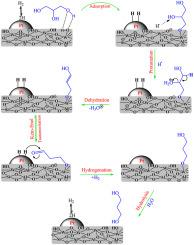双功能Pt/STA/β沸石催化剂上硅钨酸对甘油选择性氢解制1,3-丙二醇的促进作用
IF 4.7
3区 材料科学
Q1 CHEMISTRY, APPLIED
引用次数: 0
摘要
甘油选择性转化为1,3-丙二醇(1,3- pdo)是具有挑战性的,因为它的羟基的反应活性不同,导致低反应速率和选择性。本研究确定了一种最佳的催化剂配方,并考察了其组分的作用。合成了一种新型硅钨酸(STA)促进Pt-β-沸石催化剂,具有高Si/Al比(Si/Al = 300),通过改变STA的负载,在浆料间歇式反应器中评价其在甘油氢解中的性能。采用N2物理吸附、x射线衍射(XRD)、NH3-TPD、H2-TPR、CO化学吸附、以吡啶为探针的FT-IR (Py- ir)、以吡啶/2,6-二叔丁基吡啶为探针的热重分析(TGA) (Py/dTBpy-TGA)、HR-TEM和XPS对催化剂进行了表征。XRD证实钨青铜相(H0.53WO3)的存在,提高了甘油转化率和1,3- pdo的选择性。将sta -β-沸石比提高至0.3时,转化率和选择性均有所提高,超过0.3后,转化率虽高,但选择性下降。Pt/0.3STA/β-沸石催化剂具有较强的Brønsted酸性、增强的Pt- sta相互作用、优异的Pt分散性和氢气溢出性,具有较高的1,3- pdo选择性和产率。与Pt/β-沸石相比,该催化剂的1,3- pdo产率提高了10倍,选择性提高了6倍。在220℃、4 MPa条件下反应5 h后,Pt/0.3STA/β-沸石催化剂在25%转化率下的选择性达到31.40%。相比之下,未促进的Pt/β-沸石由于其较低的酸度和主要的刘易斯酸位点而有利于1,2- pdo的形成。考察了甘油浓度、温度、H2压力、催化剂组成、铂负载和反应时间等因素对反应的影响,确定了最佳条件。最后,根据反应物-产物谱,提出了甘油合成1,3- pdo的反应机理。本文章由计算机程序翻译,如有差异,请以英文原文为准。

Promoting effect of Silicotungstic acid on selective hydrogenolysis of glycerol to 1,3-propanediol over bifunctional Pt/STA/βzeolite catalysts
Selective conversion of glycerol to 1,3-propanediol (1,3-PDO) is challenging due to the differing reactivities of its hydroxyl groups, leading to low reaction rates and selectivity. This study identifies an optimal catalyst formulation and examines the role of its components. A novel Silicotungstic acid (STA)-promoted Pt-β-zeolite catalyst with a high Si/Al ratio (Si/Al = 300) was synthesized, varying the STA loading to evaluate its performance in glycerol hydrogenolysis using a slurry batch reactor. The catalysts were characterized by N2 physisorption, X-ray diffraction (XRD), NH3–TPD, H2-TPR, CO chemisorption, FT-IR with pyridine as probe (Py-IR), thermogravimetric analysis (TGA) with pyridine/2,6-di-tert-butylpyridine as a probe (Py/dTBpy-TGA), HR-TEM, and XPS. XRD confirmed the presence of the tungsten bronze phase (H0.53WO3), which enhances glycerol conversion and 1,3-PDO selectivity. Increasing the STA-to-β-zeolite ratio up to 0.3 improved both conversion and selectivity, beyond which selectivity declined despite higher conversion. The Pt/0.3STA/β-zeolite catalyst exhibited the highest 1,3-PDO selectivity and productivity due to its strong Brønsted acidity, enhanced Pt-STA interaction, superior Pt dispersion, and hydrogen spillover. Compared to Pt/β-zeolite, this catalyst increased 1,3-PDO productivity tenfold and selectivity sixfold. After 5 h of reaction at 220 °C and 4 MPa, Pt/0.3STA/β-zeolite catalyst achieved 31.40 % selectivity at 25 % conversion. By contrast, unpromoted Pt/β-zeolite favoured 1,2-PDO formation due to its lower acidity and predominant Lewis acid sites. The effects of glycerol concentration, temperature, H2 pressure, catalyst composition, Pt loading, and reaction time were also investigated to determine optimal conditions. Finally, a reaction mechanism for 1,3-PDO synthesis from glycerol is proposed based on reactant-product profiles.
求助全文
通过发布文献求助,成功后即可免费获取论文全文。
去求助
来源期刊

Microporous and Mesoporous Materials
化学-材料科学:综合
CiteScore
10.70
自引率
5.80%
发文量
649
审稿时长
26 days
期刊介绍:
Microporous and Mesoporous Materials covers novel and significant aspects of porous solids classified as either microporous (pore size up to 2 nm) or mesoporous (pore size 2 to 50 nm). The porosity should have a specific impact on the material properties or application. Typical examples are zeolites and zeolite-like materials, pillared materials, clathrasils and clathrates, carbon molecular sieves, ordered mesoporous materials, organic/inorganic porous hybrid materials, or porous metal oxides. Both natural and synthetic porous materials are within the scope of the journal.
Topics which are particularly of interest include:
All aspects of natural microporous and mesoporous solids
The synthesis of crystalline or amorphous porous materials
The physico-chemical characterization of microporous and mesoporous solids, especially spectroscopic and microscopic
The modification of microporous and mesoporous solids, for example by ion exchange or solid-state reactions
All topics related to diffusion of mobile species in the pores of microporous and mesoporous materials
Adsorption (and other separation techniques) using microporous or mesoporous adsorbents
Catalysis by microporous and mesoporous materials
Host/guest interactions
Theoretical chemistry and modelling of host/guest interactions
All topics related to the application of microporous and mesoporous materials in industrial catalysis, separation technology, environmental protection, electrochemistry, membranes, sensors, optical devices, etc.
 求助内容:
求助内容: 应助结果提醒方式:
应助结果提醒方式:


